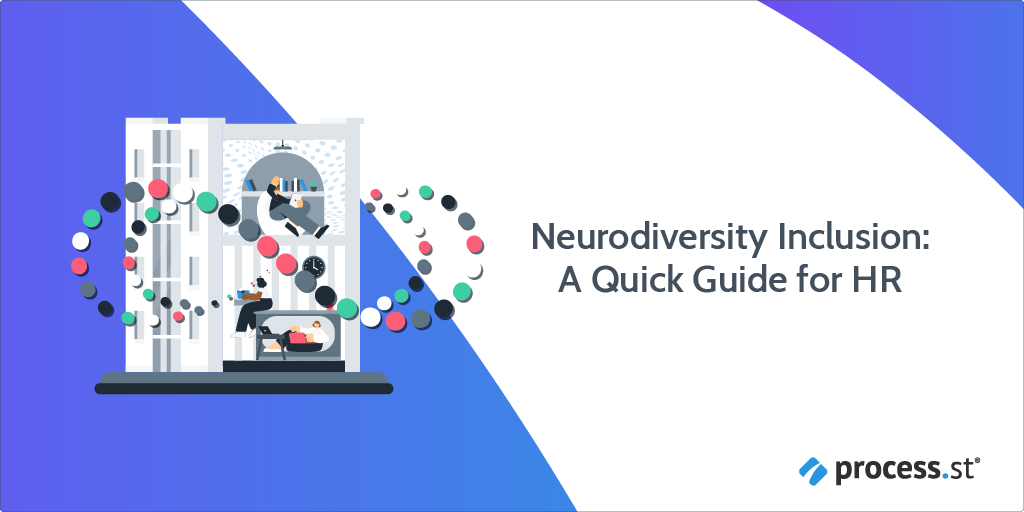
I have a brain goblin.
At least, that’s what I call it. Others might use neurodivergent, neurodiverse, neuroatypical – a lot of neuro-something, basically – or the more specific category they fall into (ADHD, autism, etc.).
Everyone has their own relationship with language, though – personally, culturally, socially – and for me, “brain goblin” sums up my experience pretty well.
Around 20% of the world’s population is neurodiverse. A CDC estimate places about 5.5 million adults in the US.
That’s the total population of LA and Dallas combined – and that’s just the number of adults.
“Neurodiverse” covers a lot of territory, but it’s safe to assume that – with 1 in 8 people considered to be neurodiverse – some of them are your employees, even if you aren’t aware of it. In fact, they may not even be aware of it: Less than 50% are aware they could be considered neurodiverse.
The aim of this post is to give you some actionable steps you can take to improve neurodiversity inclusion in your organization.
Come to think of it, a lot of your employees would probably appreciate them, not just the ones caring for brain goblins.
- Neurodiversity 101: The very basic basics
- Accessibility challenges for neurodiverse employees
- The importance of words for neurodiversity inclusion
- Building an inclusive work environment
- Neurodiversity inclusion: Understanding thought processes
- Fixations & obsessions: Mastering flexibility
- Executive dysfunction in neurodiverse employees
- Neurodiversity inclusion & the human factor
Neurodiversity 101: The very basic basics
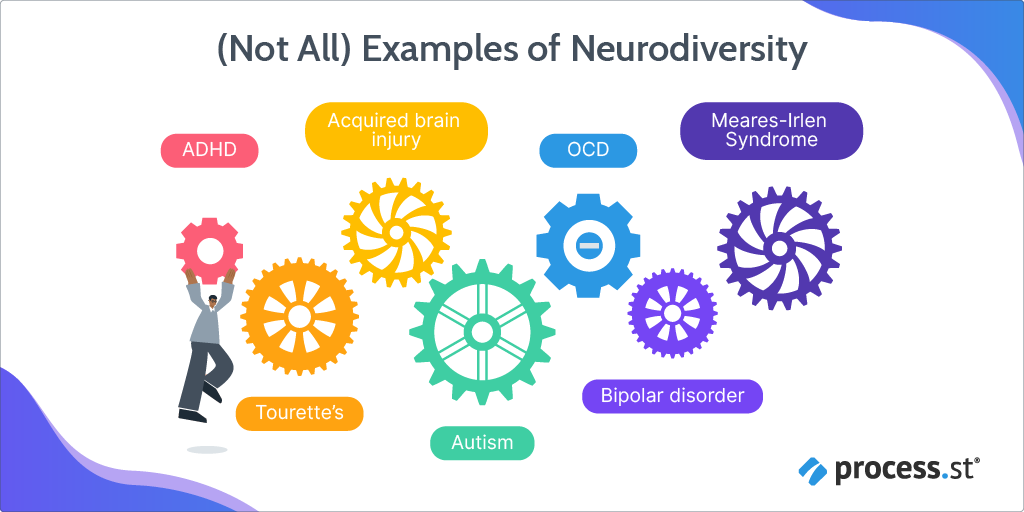
For the sake of simplicity, I’m going to use the terms “neurodiverse” and “neurodiversity.” Not everyone uses these terms and not everyone likes them. As with most things, it’s best practice (and good etiquette) to act on (and ask) someone’s preference.
While initially meant to alleviate some of the negativity associated with the term “autism,” it’s since become applied to a wide variety of neurodivergent features from categorizable ones like ADHD, Tourette’s, and autism to those with no categorization.
The most crucial thing about neurodiversity is to remember that being neurodiverse isn’t exclusively a good thing but it’s not exclusively a bad thing either – even for a single person in a single moment. It’s not a simple experience.
The fine line between typical and atypical
If you’re thinking of media representations of neurodiversity, you’re probably stuck on that bit in the introduction where I said over half of neurodiverse people aren’t even aware of it.
How could the Sheldon Coopers, Shaun Murphys, and “Bones” Brennans of the world not realize they’re out of step with everyone else?
Well, you think your brain’s normal, too, don’t you?
The point being – and it shouldn’t really need to be said – there’s nothing typical about being atypical. As a result, indications get overlooked and people who “don’t look neurodiverse” aren’t able to access (or be aware of) services they might need.
Accessibility challenges for neurodiverse employees
The obstacle to making workplaces accessible for your neurodiverse employees is that there’s no standard to provide inclusion for all neurodiverse individuals.
Ramps and elevators can make a workplace wheelchair accessible. Large print or text-to-speech software can be used for visually impaired employees while subtitles or speech-to-text software is useful for hearing impairments.
To improve neurodiversity inclusion, however, it can be difficult to know what to do.
The importance of words for neurodiversity inclusion
Back to the subject of brain goblins.
How you should refer to a person with disabilities – or even if you should use the term “disabilities” – varies greatly from person to person. Most people have very strong feelings about the words used to describe them, however.
When you get right down to it, that makes complete sense. In terms of neurodiversity, there are two main camps (and brain goblins): identity-first language and person-first language.
I’m sure you’re asking yourself now: Aren’t those the same thing?
Well, not exactly. Check out this cool little diagram:
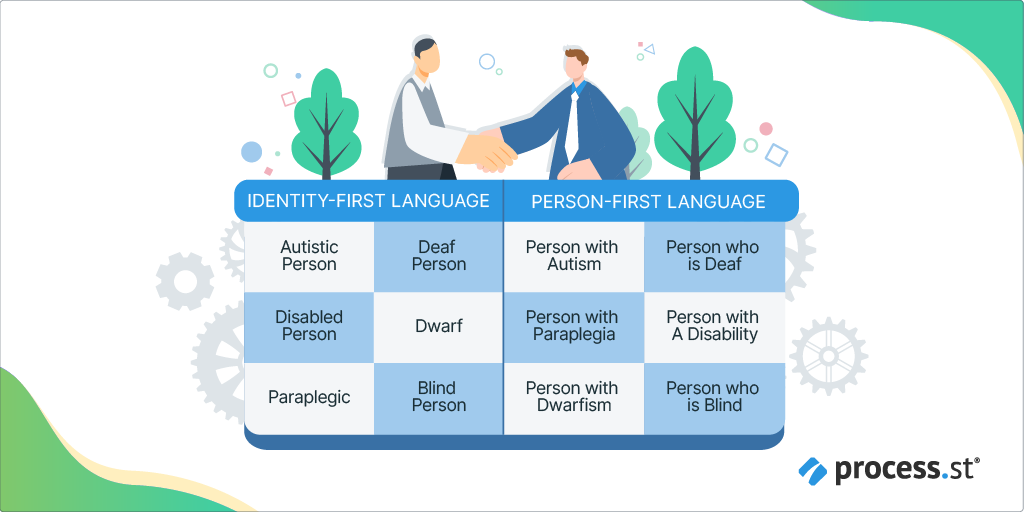
Identity-first language places the condition before the individual. For example, “autistic person” or “deaf person”; the condition forms part of that individual’s identity and so gets treated as an adjective.
It’s a little similar to referring to someone as “the tall man” or “the curly-haired woman”; you’re using a characteristic to identify the person.
Person-first language, on the other hand, puts the person… first. Before acknowledging the condition, you recognize the person it’s attached to.
The controversy with these approaches is centered on the stigma that’s been attached to what various words mean. Terms used to describe neurodiverse individuals – or anyone with a difference or disability – are often derogatory and demeaning. These terms have become so ingrained in everyday speech, though, that most people don’t realize how offensive what they’re saying actually is.
I’m sure you’ve used at least a few:
- That’s crazy!
- That video is hysterical!
- Don’t be an idiot.
- Reality shows are so dumb.
- She’s a maniac.
All of these words were originally used to refer to people with various disabilities and conditions – and not in a nice way. If you’re truly committed to creating an inclusive environment for neurodiverse employees, you need to examine the words you’re using.
Follow your employee’s lead. If they say they’re autistic, use autistic. If they refer to themselves as a person who is deaf, refer to them as a person who is deaf. If they say they have a brain goblin, feel free to laugh and ask what the hell they’re talking about.
Building an inclusive work environment
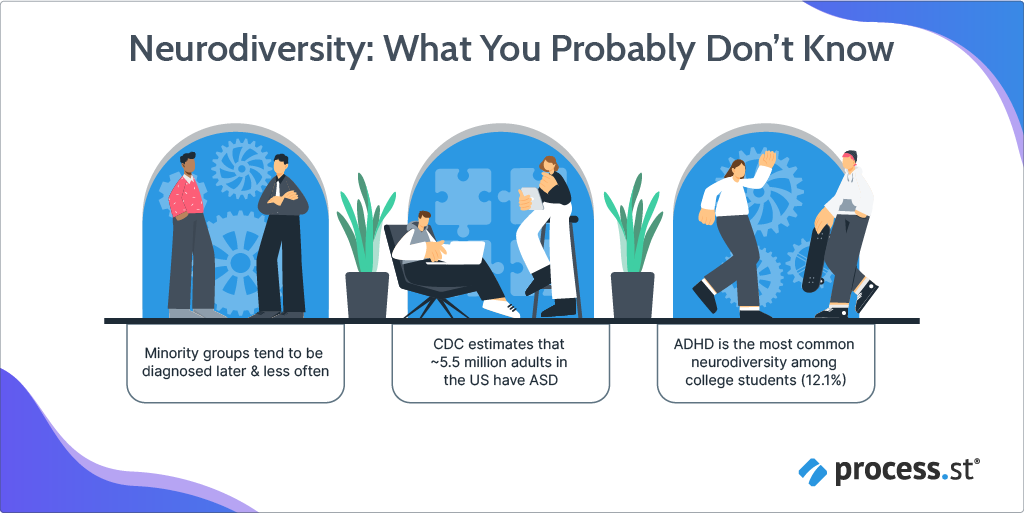
There can be a number of factors that influence a neurodiverse employee’s ability to concentrate.
Workplaces – most public places, actually – are full of distractions. Most people get used to filtering out these distractions, especially ones they’re exposed to on a regular basis.
For neurodiverse brains, this can be a lot more challenging. Sensory overload (sensitivities to light, sound, smells, and textures) can be extremely distracting. Open-plan office spaces can also be difficult with coworkers constantly moving around them.
Work environment: How you can help
Changing the way your workspace or office is set up can seem daunting and even impossible. In an ideal world, neurodiversity will be taken into consideration by designers when building inclusive and accessible spaces.
But I’m going to presume that you’re looking around your office right now wondering how you’re ever going to make it accessible.
If you have a huge budget, take advantage of the opportunity to redesign the whole place. Fortunately, though, making your workplace inclusive for your neurodiverse employees doesn’t need a complete overhaul.
Look around your office and ask yourself these questions:
- Do you have a lot of reflective surfaces?
- Is the brightness of your lights adjustable?
- How soundproof are meeting rooms and corridors?
- Are there nearby machines like coffeemakers that make a lot of noise?
- Do the fabrics in your obvious use a lot of stark patterns or contrasting colors?
- Is your office layout difficult to navigate or does it have a structured layout?
The solutions here are quick and simple. Put down carpets and rugs to minimize reflective surfaces. With smart lightbulbs, you can control the brightness and color of your office lights from an app – or even enable your employees to adjust the brightness to comfortable levels themselves.
When it comes to sound, try some of these options:
- Glazing for windows and/or glass meeting rooms
- Soundproofing for corridors and walls
- Carpets or padded feet for chairs on hard floors
- Placement of appliances
Open-plan layouts can be especially challenging for a neurodiverse employee. There’s a lot more noise and activity happening around them and far more distractions than in a traditional office.
If you have the space, you can set up a “quiet room” that your employee can go to when they feel overwhelmed or overstimulated. This allows them the opportunity to decompress and get a breather from what is – ultimately – an incredibly stressful situation for them.
If a separate room isn’t an option, look into the possibility of office pods. You see them most in universities and libraries, but office pods are compact, adjustable cubicles that offer both privacy and sound-muting.
Neurodiversity inclusion: Understanding thought processes
Cognitive rigidity is a fancy word for not being able to adapt to new situations.
In the workplace, this can come across as someone being stubborn, obstinate, or the more colloquial term: Asshole.
The difference is that stubbornness is a choice not to compromise while cognitive rigidity is the inability to imagine other possibilities.
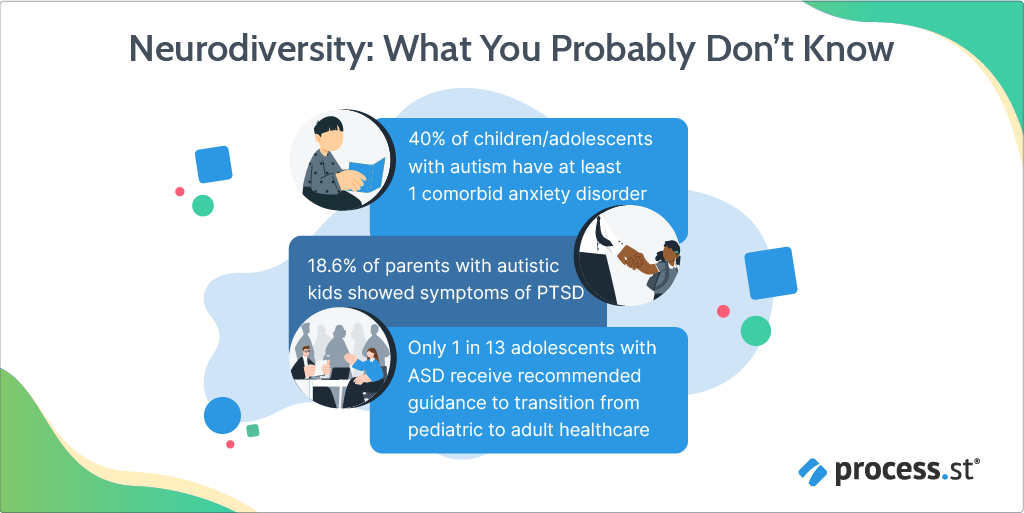
An organization is a fluid creature. Some people leave, a few get promoted, new people come in; there’s a lot of change going on that’s just part and parcel of workplace culture.
For someone with neurodiversity, however, these changes can be incredibly difficult and distressing to manage. Whether it’s an inability to adopt a new methodology, use a new piece of equipment, or even that there’s a new brand of coffee in the breakroom, these changes may have a huge impact.
Creating structure: How you can help
Structure and communication are going to be your primary pillars here. If a change – big or small – is coming, prepare your employee for it in advance.
Talk them through the timeline, possible situations they could find themselves in, and likely outcomes. Give them a clear, specific, and simplified view of what they can expect so they feel prepared when the event actually happens.
Using a change management plan like Lewin’s Model or the McKinsy 7-S Model could be a great way for both you and the employee to practically map out what to expect and provide your employee with a resource they can review as needed.
The best thing you can do for your employee during these transitions is to find out what they need and do what you can to support them. Also, consider whether the change is strictly necessary – at least for that employee.
If you want to get a new type of keyboard for everyone in the office, but your employee is only comfortable with the old model, do they really need the new keyboard?
Alternatively, find out why your employee likes their current keyboard. Is it the responsiveness, the texture, or the sound of the keys? Can you find a new model that’s similar enough that your employee will have an easier time with the transition?
Above all, if possible, don’t surprise your employee with a sudden change. Give them time to process the details so they are able to have a sense of control over the situation.
Fixations & obsessions: Mastering flexibility
Regardless of how glorified work addiction and over-working is, though, this sort of obsessiveness is neither healthy nor productive. There’s the risk of burnout, of course, as well as team morale, accuracy, interpersonal conflict, and more.
An employee with neurodiversity can become so fixated on a particular task that they become unaware of anything else around them.
Your employee might take too much time trying to perfect a single part of a project and not have enough time to finish other elements. This could also have a domino effect on their colleagues. If Greg is waiting for Sandy to finish X but she’s stuck on a minute detail that won’t affect the overall result, the whole thing gets stalled.
Your employee may also not be able to perform their responsibilities due to fixating on a particular concept or object.
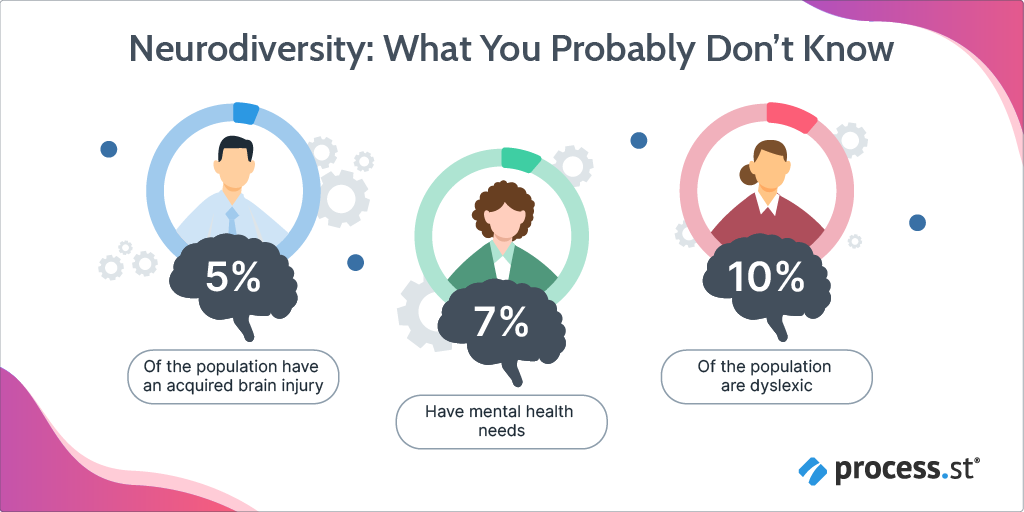
Safe spaces: How you can help
The best thing you can do for an employee with an obsession or fixation on a particular item is to be flexible and patient.
First and foremost, start with how you manage your team. Help them understand what these behaviors are, where they come from, and address any misconceptions they may have. Armed with the correct information, your team will be able to find ways to support neurodiverse inclusivity in their day-to-day actions.
Consider what you can do to reduce stress and increase comfortability:
- Does your employee need additional time to complete certain tasks?
- Are they taking enough breaks and/or taking breaks when they should?
- Do they need a more flexible schedule?
- Is there a place they can work alone and away from others?
Be aware that your employee may be incredibly self-conscious about their obsessive behaviors or fixations. They may be worried about asking for assistance or what coworkers might think. Creating a sense of psychological safety at work is crucial to improving inclusivity for neurodiverse employees.
Including an employee assistance program (EAP) in your benefits package is also a good way to support your neurodiverse employees. While EAPs were initially designed to help with addiction, they’ve expanded to include any personal situation that could adversely affect someone’s performance at work.
Executive dysfunction in neurodiverse employees
Executive functions are controlled by the frontal lobe and are the skills that make sure you get things done.
Important things, like:
- Time management
- Multitasking
- Paying attention
- Remembering details
- Planning/organizing
So when your executive functions aren’t working properly, you can have trouble completing projects, managing school and/or work responsibilities, maintaining relationships, and controlling impulses.
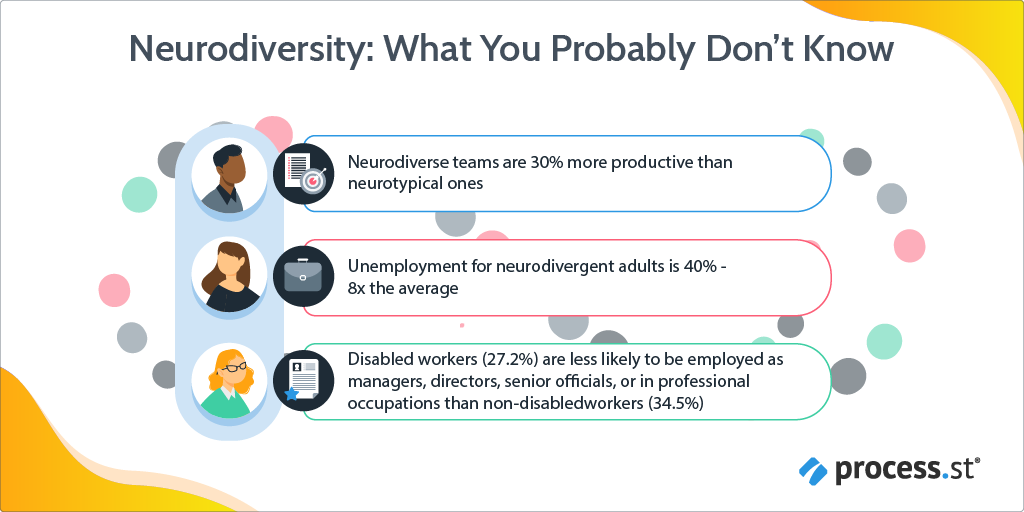
As you can imagine, executive dysfunction can add a lot of complications to your neurodiverse employee’s life – and probably their colleagues as well.
Executive dysfunction is a direct result of how a person’s brain works. This encompasses addictions, depression, brain tumors, Alzheimer’s, and any condition or circumstance that causes damage to the brain.
Since executive dysfunction plays a strong role in a person’s ability to complete tasks and stick to a schedule, your other employees may feel that they’re being asked to work harder or do more than their colleague.
If your employees resent their neurodiverse colleagues, building neurodiversity inclusion within your team will be next to impossible. Establishing systems and strategies early on that ensure everyone stays on track are vital to maintaining employee morale.
Getting things done: How you can help
There are a number of techniques designed to help with executive dysfunction but it’s not something that can be “fixed.”
A few systems you can set up are:
- Visual aids for organization
- Techy tools (organizers, computers, smart watches, etc.)
- Give written instructions as well as oral
- Break big projects into smaller chunks
- Set time limits for a set task (like the Pomodoro technique, for example)
- Present meeting materials and agendas in advance
The downside to some of these methods is that they do require some very active participation from your employee, which doesn’t solve the initial problem.
Check in with your employee regularly to see how they’re doing and how these methods are working. It may take some trial and error to find one that works really well for your employee, but once you do, you’ll both be much happier.
Neurodiversity inclusion & the human factor
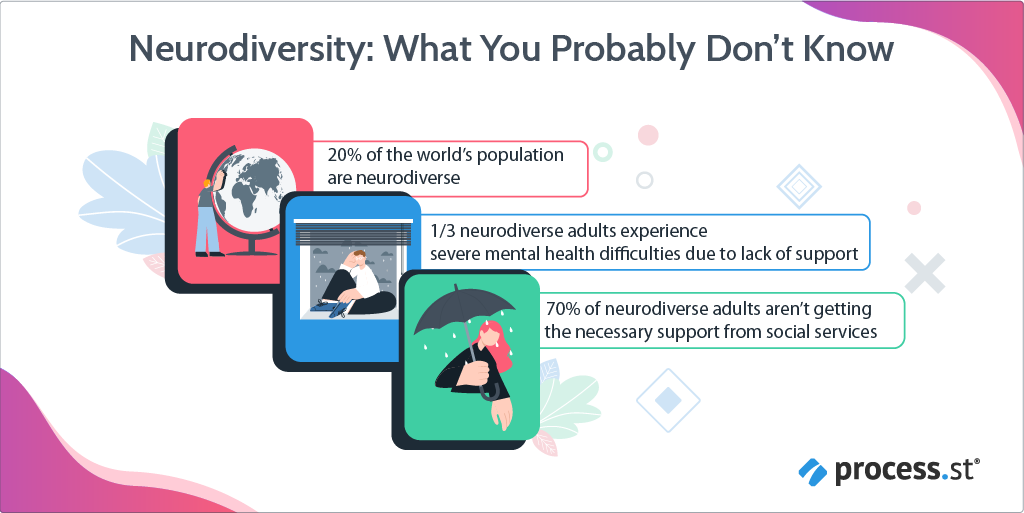
Difficulty navigating interpersonal relationships is generally the first thing people think of when neurodiversity comes up. Being neurodiverse, however, is not a free pass to be an asshole, and most neurodiverse people know that.
In fact, not understanding the why of human interaction can be confusing, isolating, and upsetting.
One of the biggest obstacles to neurodiversity inclusion is this difficulty with interpersonal relationships. Your neurodiverse employee may say something too bluntly or not pick up on certain social cues.
If you don’t establish clear expectations and boundaries for social interactions at your organization, you’re leaving the door open for a whole mess of problems for all of your employees.
Work relationships: How you can help
First things first: Employees with neurodiversity do have emotions just like anyone else.
Media representations of neurodiversity as cold and stoic can actually be harmful to the well-being of neurodiverse people.
Your employee may not be able to express themselves as clearly as others or interpret specific interactions, but you shouldn’t presume it’s the result of not feeling.
Outline the social expectations and etiquette of your workplace if very clear, simplistic terms. Don’t use metaphors or euphemisms; state what you mean explicitly and provide a guideline for how your employees should behave at work.
A great tactic to facilitate this is to prepare a personal user manual that you can give to your employees. A personal user manual outlines your expectations of your team, your management style, and other important details like when you’re accessible for a 1:1.
Not only will a document like this be valuable for your neurodiverse employees, but it’s a great resource during onboarding to give your new hires a sense of what it’ll be like to work with you.
Providing an anchor person or mentor is also a good idea. This person is someone your neurodiverse employee can go to for advice, information, or just general support while navigating the workplace.
An anchor person should be familiar with and able to understand your employee’s specific needs in order to best act as a guide for the employee.
What advice would you give your employers about creating neurodiverse-accessible workplaces? Add your comments and suggestions below!







 Workflows
Workflows Forms
Forms Data Sets
Data Sets Pages
Pages Process AI
Process AI Automations
Automations Analytics
Analytics Apps
Apps Integrations
Integrations
 Property management
Property management
 Human resources
Human resources
 Customer management
Customer management
 Information technology
Information technology



Leks Drakos
Leks Drakos, Ph.D. is a rogue academic with a PhD from the University of Kent (Paris and Canterbury). Research interests include HR, DEIA, contemporary culture, post-apocalyptica, and monster studies. Twitter: @leksikality [he/him]